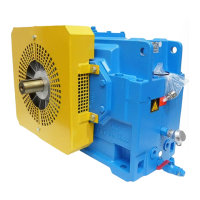65 / 96
BA 5030 en 02/2013
3
3
3
3
1
2
Fig. 53: Example of alignment on a flexible coupling
1 Ruler 2 Feeler gauge 3 Measuring points
The maximum permissible misalignment values are specified in the operating
instructions for the coupling; they must under no circumstances be exceeded during
operation.
Angular and radial misalignments may occur at the same time. The sum of both
misalignments must not exceed the maximum permissible value of the angular or
radial misalignment.
If you use couplings manufactured by other manufacturers, ask these manufacturers
which alignment errors are permissible, stating the radial loads occurring.
For alignment of the drive components (vertical direction), it is recommended to use packing
or foil plates underneath the mounting feet. The use of claws with set screws on the foundation
for lateral adjustment of the drive components is also advantageous.
In the case of gear units with hollow output shafts or flange output shafts, the coupling on the output side
is not required. Gear units with hollow output shafts must be mounted on the shafts of the customer’s
machinery. Gear units with flanged output shafts must be mounted on the customer’s shaft via
a counterflange.
6.9 Gear unit with flanged shaft
The front area of the flanged shaft must be absolutely free of grease.
This is essential for safe and reliable torque transmission. Do not use contaminated
solvents or dirty cloths for removing grease.
Before tightening the tensioning bolts it must be ensured that the flange centring
means are inserted one inside the other.
Then tighten diametrically opposed tensioning bolts to full torque.
The following tightening torque of flange bolts apply to gear units:
Table 20: Tightening torques for flange connections
Gearunit size
Strength class
Tightening
torque
Bolt
DIN 931
Nut
DIN 934
5 ... 6 10.9 10 610 Nm
7 ... 10 10.9 10 1050 Nm
11 ... 16 10.9 10 2100 Nm
17 ... 20 10.9 10 3560 Nm
21 ... 22 10.9 10 5720 Nm

